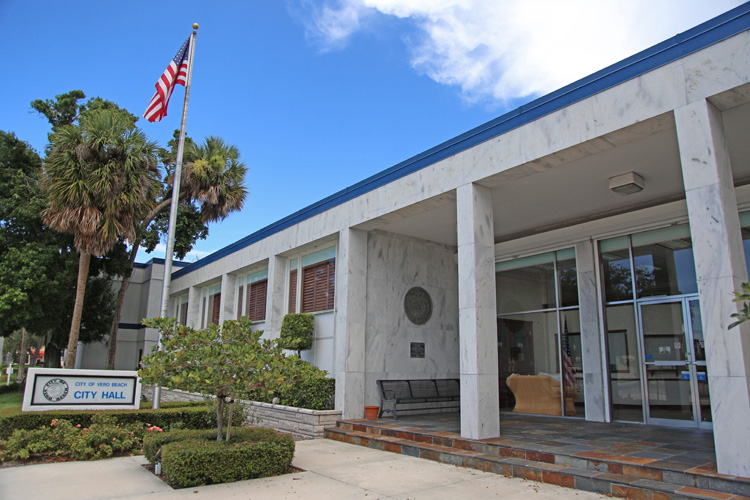
There was no do-nothing option this time – not if Vero Beach wanted to stay in the water-and-sewer business, and not if the city hoped to follow through with its wildly popular plan to develop a dining, retail and recreational hub on mainland’s waterfront.
Simply put: The City Council needed to approve rate increases of 15 percent in January, 18 percent in October and another 18 percent in October 2024 for its water-and-wastewater utility.
Those increases will be consolidated for customers throughout the city’s service area and result in the average water-sewer bill rising from $51 to $59 in January, to $69 in October and to $82 in October 2024, all based on the use of 4,000 gallons per month.
They will cover not only the utility’s operating and maintenance deficits, but also provide the funding needed to build a new wastewater-treatment facility at the Vero Beach Regional Airport.
“Sometimes, the unpopular decision of spending money and investing money in the future of your community has to be made,” Vero Beach Mayor John Cotugno said before the City Council voted 4-1 last week to approve the rate hikes. “This could be that unpopular decision.”
Oh, it will be.
Two years from now, the average city-system customer will be paying $360 more per year for water and wastewater service.
That’s why City Council newcomer Tracey Zudans voted against the increase, citing the previous council’s adoption of a stormwater utility tax and a rise in property-tax bills because of higher real-estate values.
“It’s a really big pill for our residents to swallow,” Zudans said, “to ask them for a high rate increase right now.”
Unlike too many of its predecessors the past 12 years, however, this City Council understood that it no longer could afford to postpone the pain of a rate increase needed to operate and maintain the utility.
Nor could this Council justify putting off construction of a new $82 million wastewater-treatment facility to replace the city’s already-outdated plant on the banks of the environmentally troubled Indian River Lagoon, where the existing structure was built in the 1970s.
“That plant is way beyond its useful life and would need to be brought up to current environmental standards,” Cotugno said after the meeting. “So we either build a new facility for $82 million, or we refurbish the existing plant for 70 to 75 percent of that amount.
“And if we choose the latter,” he added, “we’d still have a wastewater plant on the lagoon.”
That, too, poses a problem.
If the wastewater plant isn’t moved, the city would lose nearly half of the 35 acres needed for its much-heralded Three Corners project at the west end of the 17th Street Bridge.
And with an active wastewater facility to the immediate south, it’s unlikely any developer would invest in the adjacent, 17-acre property that currently contains the city’s defunct power plant.
“We can’t do the Three Corners project without moving the wastewater plant,” Cotugno said.
“So when you take everything into consideration, we really had no choice. We had to act.
“As unpopular was these increases might be, we couldn’t continue to kick the can down the road,” he added. “We’ve run out of road.”
Besides, it’s only a matter of time before state officials step in and mandate the city’s existing wastewater plant be upgraded or shut down. They’re already encouraging cities and counties to move such facilities off environmentally troubled waterways.
Cotugno warned that state regulations governing wastewater treatment facilities will only become more stringent as environmental concerns become more prominent – “and they’ll most likely appear as unfunded mandates.”
Certainly, it was time for the city to simplify its rate structure by consolidating all of the utility’s customers – in the city, county (South Beach area) and Indian River Shores – so they’re all being charged the same rates.
For those wondering: The city has temporarily exempted from the increases the reuse-irrigation water rate for Indian River Shores customers, pending an appeals-court ruling in the town’s 2020 breach-of-contract case against Vero Beach.
In a Dec. 5 letter to the City Council, however, Shores Mayor Brian Foley expressed concerns about sewage rates that he claimed would “disproportionately affect customers outside the city” and impact towns residents who “do not have an electoral voice.”
Foley also wrote that the town objects to any rate increase that results in its residents being charged more than the county’s water and wastewater rate.
According to the study conducted by a city consultant, the county’s combined rate is only $47 per month for 4,000 gallons – about $12 less than Vero Beach’s rate.
Even with the increases, though, Vero Beach’s rates remain well-below those in nearby cities, including Palm Bay ($80), Fort Pierce ($77), Stuart ($68) and Melbourne ($66).
And we don’t know when the county, which recently commissioned a water-quality study in response to complaints about copper pipe leaks, will seek its next rate hike.
Still, the city’s rate increase is significant, coming during these inflationary times, and it might cause a hardship for some in our community. But even if you remove construction of a new wastewater facility from the equation, rates needed to rise.
As City Manager Monte Falls told the council members before they voted: “There’s no zero-cost option.”
The city has applied – and will continue to pursue – state and federal grants to offset some of the estimated $82 million cost of building a new wastewater plant. But those monies aren’t likely to offer much help: The average customer would see only a $3 reduction in his or her monthly bill for every $10 million the city receives.
Former mayor Robbie Brackett, who last month was elected to the Florida House of Representatives, said he would assist the city’s efforts in obtaining state monies for the project.
“We’ve enjoyed low rates for a long time,” he said, “but it’s time to get that plant off the lagoon.”
Yes, it is.
And this City Council’s decision to make it happen – to do what’s best for the community, despite the fierce blowback that’s sure to come – should be respected, maybe even applauded.
There are two reasons this increase became necessary: the failure of previous city councils to raise rates to properly fund the utility; and the need to build a new wastewater plant somewhere other than on the lagoon.
The members of this City Council boldly, courageously and wisely accepted the challenge the double whammy that was dumped in their laps.
“We were put in a difficult position,” Cotugno said, “and we made a difficult decision.”



